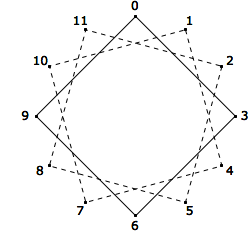Consider the group \(\mathbb{Z}_2{}^4 = \mathbb{Z}_2\times \mathbb{Z}_2\times \mathbb{Z}_2\times \mathbb{Z}_2\) . Let \(H\) be \(\langle (1,0,1, 0)\rangle\text{,}\) the cyclic subgroup of \(\mathbb{Z}_2{}^4\) generate by (1,0,1,0). Since
\begin{equation*}
(1,0,1, 0)+(1,0,1, 0)=(1+_21,0+_20,1+_21,0+_20) = (0,0,0,0)
\end{equation*}
the order of \(H\) is 2 and , \(\mathbb{Z}_2{}^4/H\) has \(\lvert \mathbb{Z}_2^4 /H\rvert =\frac{\lvert
\mathbb{Z}_2^4\rvert }{\lvert H\rvert }=\frac{16}{2}= 8\) elements. A typical coset is
\begin{equation*}
C = (0, 1, 1, 1)+H = \{(0, 1, 1, 1), (1, 1, 0, 1)\}
\end{equation*}
Note that since \(2(0, 1, 1, 1) = (0, 0, 0, 0)\text{,}\) \(2C = C\otimes C = H\text{,}\) the identity for the operation on \(\mathbb{Z}_2{}^4/H\text{.}\) The orders of non-identity elements of this factor group are all 2, and it can be shown that the factor group is isomorphic to \(\mathbb{Z}_2{}^3\text{.}\)


